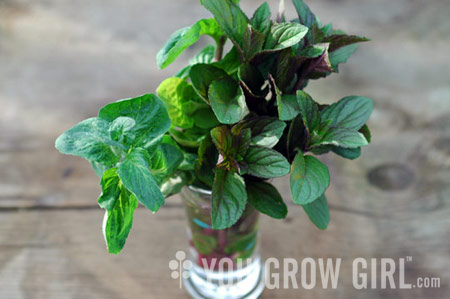
About a month ago, I wrote a guest post for Apartment Therapy/Re-Nest on propagating herbs by cuttings. This is how I quickly double my basil harvest every summer at no extra cost. Basil grows easily from seed too, but stem cuttings are fast and easy — they’ll produce roots in water in about a week or two! By mid-summer my collection of scented geraniums (Pelargoniums) are huge! Why not take a few cuttings and share the wealth with friends?
On the Re-Nest site someone asked a question about taking cuttings from bolting plants. I have not been able to post a comment so I am adding a reply here.
SoRad: We grow basil like an annual in colder climates, but in tropical conditions the plant is a perennial. There are also varieties of basil that are reproduced by cuttings only… they don’t produce seed. Some basil varieties bolt quickly and constantly, while others only do-so when the weather gets really hot.
Bolting when it comes to basil is more about the conditions a particular variety prefers rather than “age.” It is better to take cuttings from plants that aren’t under heat-stress, but I have found that it can be done successfully — your best bet is to move the rooting cuttings to a cooler spot.
—————————
Just last week a friend and I visited a large greenhouse to stock up on last-minute herbs for the growing season. As we walked the aisles, I felt more than a little guilty, if not mischievous, about the number of times I whispered to put a plant back since I already had it and would happily give her a cutting. When you’re stocking a garden for the growing season, every $3 and $4 savings really adds up quickly!
Plants such as basil, mint, and oregano are incredibly easy to reproduce from cuttings — and a heck of a lot faster than growing from seed. So easy in fact, that it is practically criminal how quickly you can stock your entire garden from one small plant. I save time and money every season multiplying my basil crop in this way.
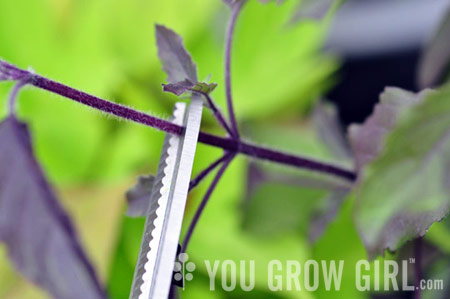
Allow new plants to grow for a few weeks to a month. When they’ve doubled in size, cut a few stems about 4 or 5 inches long just above or below a node (the juncture on the stem where leaves are attached).
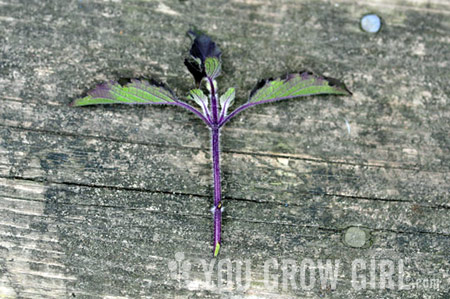
Pluck off one or two sets of leaves, and remove any flower or buds that have formed. The goal here is to keep the plant focused on growing roots and leaves; flowers (a different form of reproduction) are a big energy drain.
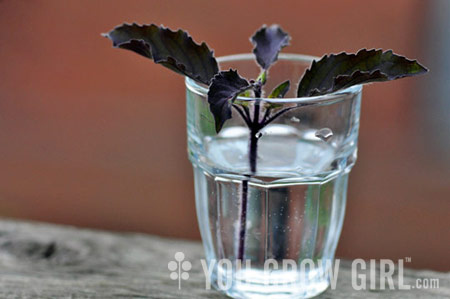
Stick the stems in a small cup or jar of water and place in a sunny but protected spot. Add more water as it evaporates; at least one node should always be submerged in water since this is where the roots will form.
That’s it. You should see roots in less than a week.
Once healthy roots have formed, pot up or plant the new plants in-ground and you’re done. You can add a little vermicompost to the hole if you want and of course water them in well to get things going.
Rooting Cuttings From Woody Stems
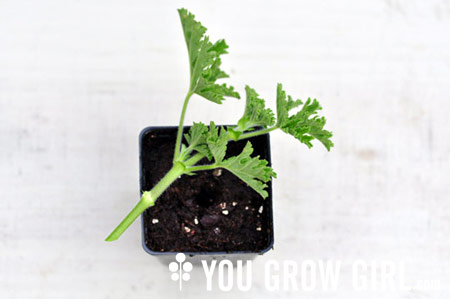
Plants with woodier stems, including rosemary, scented geraniums (aka pelargoniums), and lemon verbena tend to have a little trouble producing roots in water, but will work just as easily in a soil-like medium. Follow the directions for growing in water, but push the cutting into a small plastic pot or tray filled with well-draining potting soil, coir, or a mix of 1 part vermiculite and 1 part perlite. Keep the soil moist, but not sopping wet. I have had especially good luck allowing geranium cuttings to scab over for a day or two before potting them up.
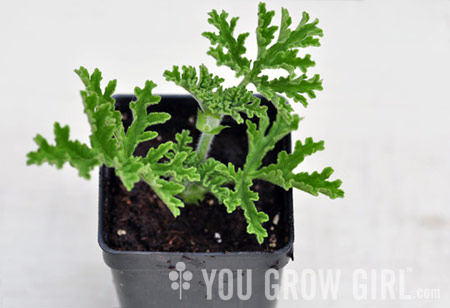
-
Herbs to Start in Water:
- Basil
- Broadleaf Thyme/Cuban Oregano
- Mint
- Oregano
-
Herbs to Start in Potting Soil/Coir:
- Broadleaf Thyme/Cuban Oregano
- Lemon Verbena
- Rosemary
- Sage
- Savory (Summer and Winter)
- Scented Geraniums
- Stevia
- Thyme
p.s. The herbs I used in these photos are Purple ‘Tulsi’ aka ‘Holy’ basil and ‘Robber’s Lemon Rose’ geranium.
And one trick I did not include in the post is that I let the geranium cutting callus or “heal over” for a few hours and up to a day before planting in soil. My friend Barry taught me this trick and it works like a charm!
Great idea, although the season is so short here it barely seems worthwhile . I am going to start another sage plant or two though and I will grow them in pots indoors till next year.
I think my spearmint is defective. I decided to try your suggestion with spearmint a few weeks ago as an experiment with the kids. Thus far it is growing new stems from the nodes underwater, but hasn’t bothered with roots.
Great idea! I will definitely do this next year.
However, I still find growing herbs from seed to be fairly rewarding and productive. One advantage is that I can start many, many TINY seedlings that don’t take up a lot of room during the “indoor growing” season.
Once I repot them outside in mid-spring, they can take off to their full dimensions – without costing a fortune in lighting on my indoor rig the way full-grown cuttings would.
Also, you don’t mention parsley – I assume it doesn’t clone well? Anyway, it’s another easy start from seed, though it takes a bit of patience while it germinates.
Edmund: Curious. I have never tried with spearmint but am wondering if it has something to do with the fact that spearmint can grow in wetland. It might just take a bit longer.
Jennifer in Mamaland: Someone asked me about fennel on twitter and my response to parsley is the same… they are rosette forming plants (and umbels) and while I have never tried, I’m fairly certain cuttings won’t work.
Seeds are definitely the way to go with both… although parsley can be a pain to germinate.
Jennifer, I have attempted parsley without any success. I am curious if anyone else out there has had better luck than me. I have had great success with oregeno/basil/mints just by placing in water.
I just did green onions from the grocery store. After chopping them up for dinner, I stuck the roots in some water. A week later they doubled their size.
we’ve grown citronella by taking a cutting, letting it scab for a day or so then sticking it directly into an existing potted plant.
… ok so this has now opened up a whole new world for me!
It’s how I’ve grown some common houseplants, but heck … basil and other herbs …
Can you hear the clinking of glass at my house as I type with one hand … thanks Gayla!
I now have stevia, applemint and strawberry sage in water. Cocoamint and basil are my favorite ones to root. I have to keep an eye on them if they are outside, cause mosquitoes lay their eggs in the water. I always start my lemongrass in water. I have to try the onions in water, I usually just stick them in the ground.
Sorry to be a pain Gayla, but what did you mean when you said “cutting callus or “heal over†for a few hours”? I have not heard that before and am curious what it means.
I think my mom wishes I never heard of this method since again I have a number of cuttings around. :p
Summer: It means to let the end (the wet, cut part) dry out slightly…
I saw a mention of your site in Cooking Light magazine,and wow–the first time I checked you out, you had a fantastic tip posted! I now have a vase of basil on my kitchen windowsill and am looking forward to setting out some new plants in the near future!
Thanks for the tip! I’m going to try this!
Thanks Gayla for the explanation.
I’m new to gardening in general and have only a very small space to do any. I have started some herbs on my back porch and tried cloning my basil plant when I read this. It’s got some roots now, about half an inch long, but I’m not sure what indicates “healthy enough” to transfer to soil. Can anyone help a newbie out?
Wow! This changes everything for me!! Thanks, going to try ASAP!
Hi Lunchbox: I usually wait until it starts to put out rootlets (secondary smaller roots off the main root) as well – it seems to have more ability to deal with potting after that.
Hi! I have a lovely rose geranium plant, which I think was given to me as a cutting 6 months ago. I tried to multiply 2 of them – one of them looks really wilted – it’s been 4 days – but it’s still green, what am I doing wrong? Also, are rose geraniums edible? How can one make oils from them and use them in say, laundry, etc?
Divya: I’ve had a few do the same thing. Sometimes it’s too much light, not enough light, inconsistent moisture… and sometimes inexplicable.
Making essential oils is not a process I have tried or am familiar with. It involves using a still, which is above my head.